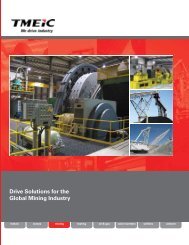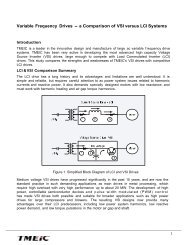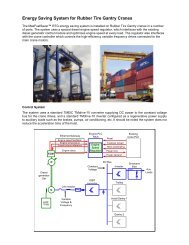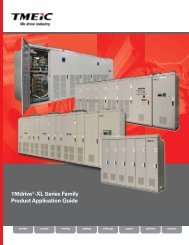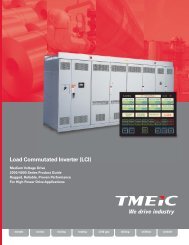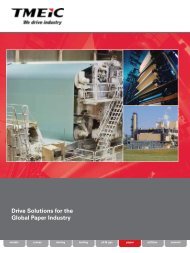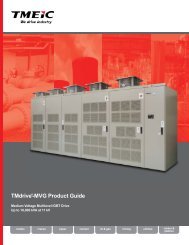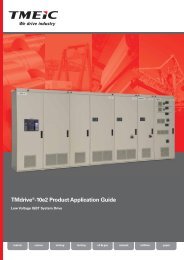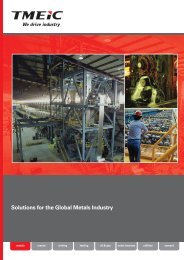Solutions for the Global Metals Industry
Solutions for the Global Metals Industry
Solutions for the Global Metals Industry
You also want an ePaper? Increase the reach of your titles
YUMPU automatically turns print PDFs into web optimized ePapers that Google loves.
Coiling Temperature ControlSteel customers today demand that mills produce specific mechanical properties <strong>for</strong> <strong>the</strong>ir products, such as yield strength,tensile strength, and elongation. The coiling temperature control maintains <strong>the</strong> rate of cooling and <strong>the</strong> final temperature(<strong>the</strong> temperature-time profile) of <strong>the</strong> strip to obtain <strong>the</strong> desired metal properties as it enters <strong>the</strong> coilers.TMEIC’s Coiling TemperatureControl (CTC) features:Physics-based ModelsThe model of <strong>the</strong> coolingprocess generates coolingwater flow setpoints,which are sent to <strong>the</strong> level1 control to produce <strong>the</strong>desired temperature-timeprofile as <strong>the</strong> strip movestoward <strong>the</strong> coilers. A processmodel encompasses variouscoiling temperature controlstrategies.Metallurgical-based ModelsThe CTC model includes<strong>the</strong> effects of <strong>the</strong> steelphase trans<strong>for</strong>mation <strong>for</strong>accurate prediction of <strong>the</strong>temperature-time profilerequired <strong>for</strong> <strong>the</strong> optimummechanical properties.MODELSSTRIP SPEEDPROFILEMILL EXITSENSORSTRACKINGPIECE SAMPLEFEEDBACKIN-COILFEEDFORWARDFINISHINGSPEEDSENSORSFM EXITTEMP.EARLY COOLINGZONEMODELSCOILINGTEMPERATUREFEEDBACKIN-COILFEEDBACKINTERMEDIATECOOLING ZONEFEEDBACKFEEDBACKSYSTEMPARAMETERSIN-COILFEEDFORWARDS ENSORSBOTTOMPYROTRACKINGPIECE SAMPLEMODELSCOILINGTEMPERATUREFEEDBACKIN-COILVERNIERSENSORSBOTTOMPYROSENSORSCOILINGTEMP.LATE COOLINGZONE - VERNIERCoiler Temperature Control SystemEarlyCoolingDUAL PHASE COOLINGRadiationLateCoolingDetails of <strong>the</strong> Coiling Temperature Control ModelThe rate of cooling, <strong>the</strong> intermediate, and final temperature, are tied to<strong>the</strong> desired mechanical properties, thus precise cooling control is critical.TMEIC’s Dual Phase Cooling model illustrated above is described here.Early Coiling Temperature Cooling ModelThe CTC model takes finishing mill exit speed and temperature plus feedback from <strong>the</strong> intermediate zone and calculates<strong>the</strong> level 1 cooling water flow setpoints <strong>for</strong> <strong>the</strong> early cooling zone to achieve <strong>the</strong> desired quench rate and intermediatetemperature.Dual Phase/Interrupted CoolingThe combination of interrupted cooling and modeling of low target temperatures achieves specific steel structures such as<strong>the</strong> bainitic and martensitic.Late Coiling Temperature Cooling ModelThis model takes <strong>the</strong> final and intermediate temperatures and calculates <strong>the</strong> late (vernier) cooling flow setpoints. Thecoiling temperature control model utilizes several techniques including feedback, feed<strong>for</strong>ward, and vernier temperaturecontrol to meet <strong>the</strong> process objectives.© 2011 TMEIC Corporation. All Rights Reserved.Page 11 of 40



